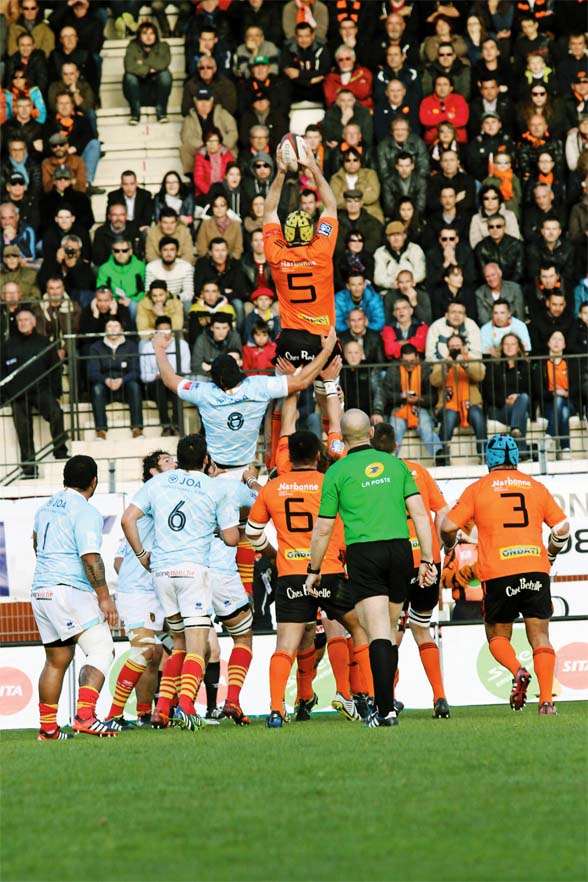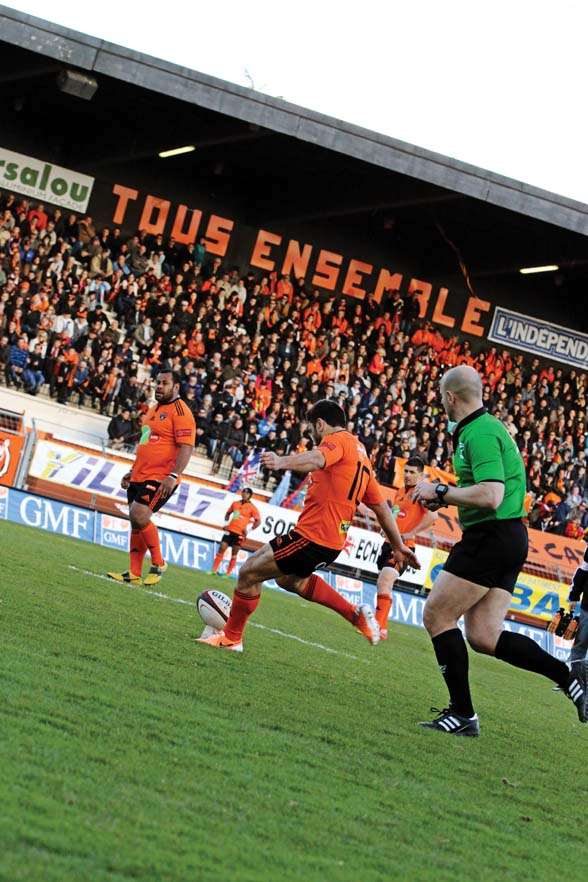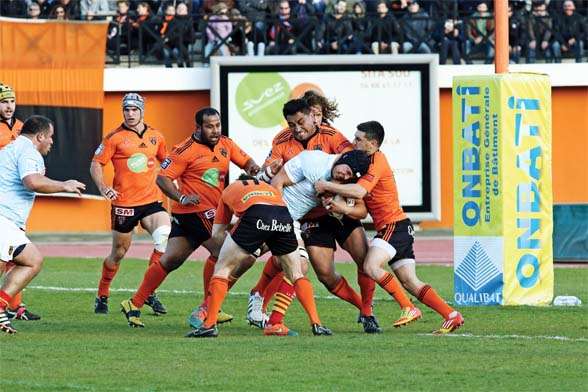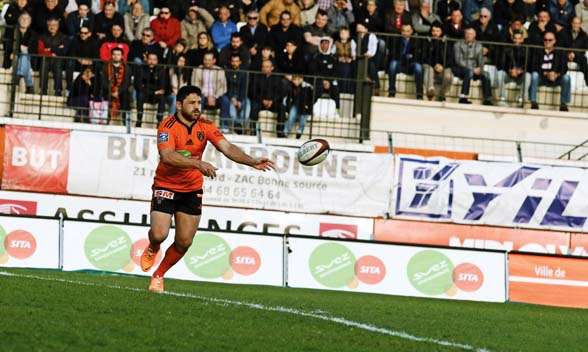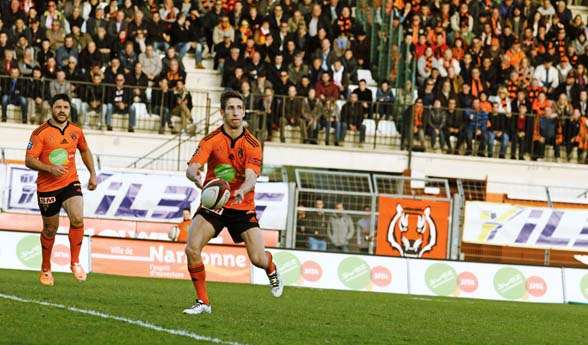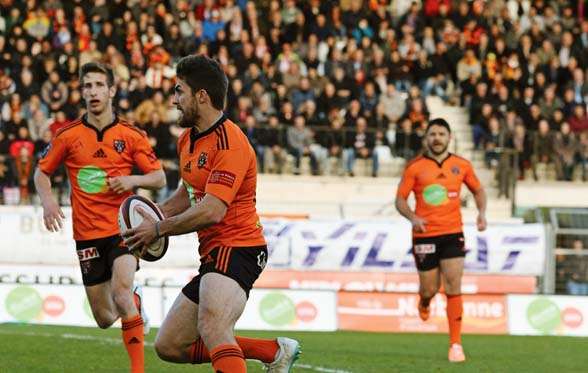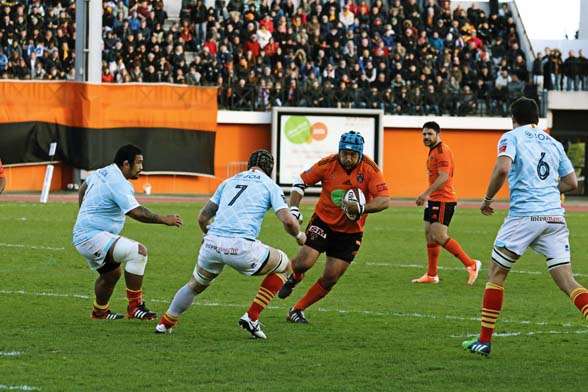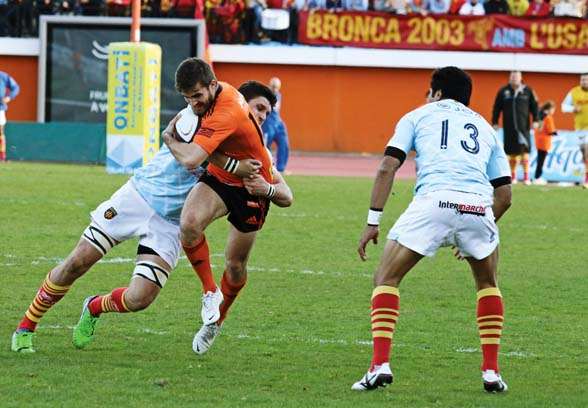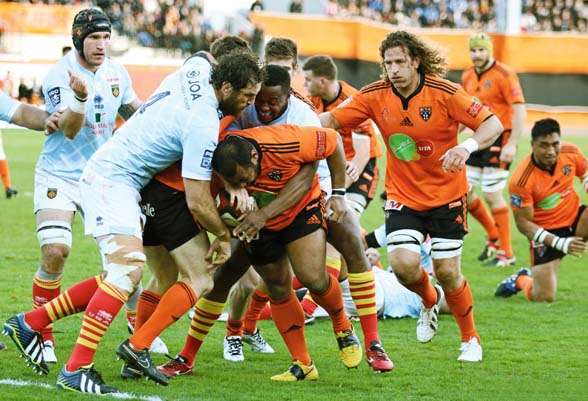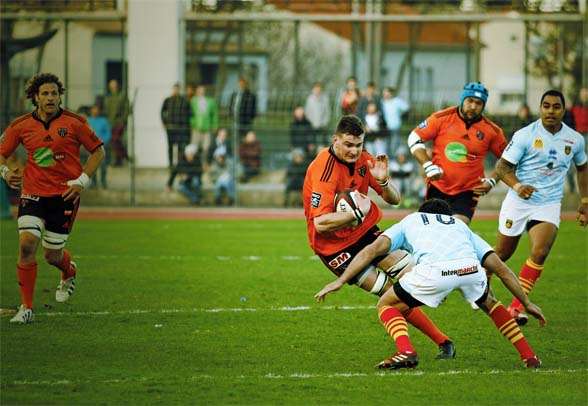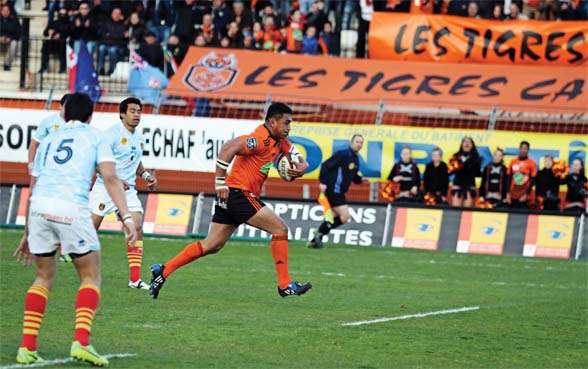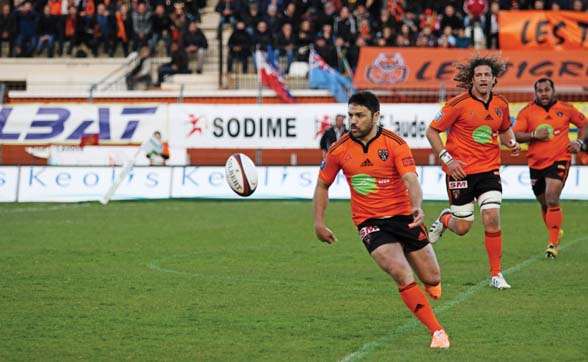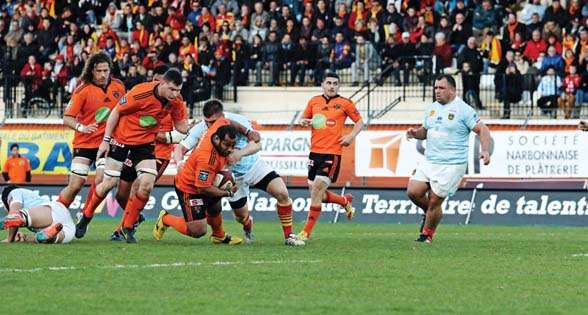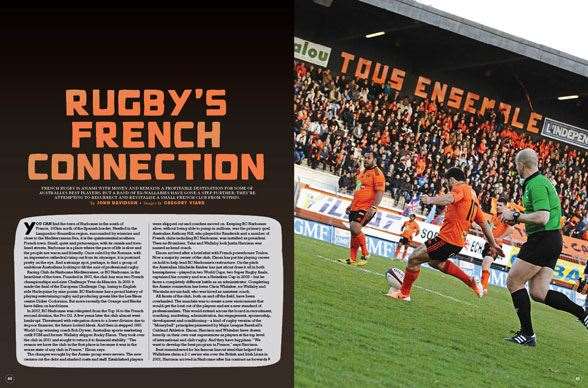Band of ex-Wallabies' quest to revitalise RC Narbonne.
(NOTE: this article appeared in Inside Sport days before the death of Jerry Collins, who is mentioned in this story. Jerry and his wife Alana passed away after being involved in a motor vehicle accident in France. Our thoughts are with their family and friends, and with RC Narbonne.)
You can find the town of Narbonne in the south of France, 100km north of the Spanish border. Nestled in the Languedoc-Roussillon region, surrounded by wineries and close to the Mediterranean Sea, it is the quintessential southern French town. Small, quiet and picturesque, with its canals and tree-lined streets, Narbonne is a place where the pace of life is slow and the people are warm and friendly. Once ruled by the Romans, with an impressive cathedral rising out from its cityscape, it is postcard pretty on the eye. And a strange spot, perhaps, to find a group of ambitious Australians looking to tilt the axis of professional rugby.
Racing Club de Narbonne Mediterranee, or RC Narbonne, is the heartbeat of the town. Founded in 1907, the club has won two French championships and nine Challenge Yves du Manoirs. In 2001 it made the final of the European Challenge Cup, losing to English side Harlequins by nine points. RC Narbonne has a proud history of playing entertaining rugby and producing greats like the Les Bleus centre Didier Codorniou. But more recently the Orange and Blacks have fallen on hard times.
In 2007, RC Narbonne was relegated from the Top 14 to the French second division, the Pro D2. A few years later the club almost went bankrupt. Threatened with relegation down to a lower division due to its poor finances, the future looked bleak. And then in stepped 1991 World Cup-winning coach Bob Dywer, Australian sports marketing outfit FGM and former Wallaby skipper Rocky Elsom. They took over the club in 2011 and sought to return it to financial stability. “The reason we have the club in the first place is because it was in the worse state of any club in France,” Elsom says.
The changes wrought by the Aussie group were severe. The new owners cut the debt and slashed costs and staff. Established players were shipped out and coaches moved on. Keeping RC Narbonne alive, without being able to pump in millions, was the primary goal. Australian Anthony Hill, who played for Randwick and a number of French clubs including RC Narbonne, was installed as president. Then ex-Brumbies, Tahs and Wallaby lock Justin Harrison was named as head coach.
Elsom arrived after a brief stint with French powerhouse Toulon. Now a majority owner of the club, Elsom has put his playing career on hold to help lead RC Narbonne’s restructure. On the pitch the Australian blindside flanker has just about done it all in both hemispheres – played in two World Cups, two Super Rugby finals, captained his country and won a Heineken Cup in 2009 – but he faces a completely different battle as an administrator. Completing the Aussie connection has been Chris Whitaker, ex-Wallaby and Waratahs scrum-half, who was hired as assistant coach.
All facets of the club, both on and off the field, have been overhauled. The mandate was to create a new environment that would get the best out of the players and set a new standard of professionalism. This would extend across the board in recruitment, coaching, marketing, administration, fan engagement, sponsorship, development and conditioning – a kind of rugby version of the “Moneyball” principles pioneered by Major League Baseball’s Oakland Athletics. Elsom, Harrison and Whitaker have drawn heavily on their own vast experiences as players at the top level of international and club rugby. And they have big plans: “We want to develop the best program in France,” says Harrison.
Best remembered for his famous lineout steal that helped the Wallabies claim a 2-1 series win over the British and Irish Lions in 2001, Harrison arrived in Narbonne after his contract as forwards coach at the Brumbies was cut short by Jake White. He admits the club’s model is unique: at its heart, it is based on recruiting powerful players looking to improve. “Rugby’s been professional enough now to be accountable for its actions,” Harrison confides. “We’re running out of excuses to get it wrong now. For a long time players and administration and coaching has dropped away because they’ve not been accountable for their own inadequacies. You need to create an environment that facilitates improvement quickly and is sustainable.”
Unable to throw huge amounts of cash at its problems or attract stars, like other clubs in France, RC Narbonne has gone a different route. Harrison likens it to the situation faced by the Brumbies when they were formed in the 1990s. Cast-offs from other provinces were recruited. Players coming back from injury, with no experience in professional rugby or eager for an opportunity, have been signed on the cheap. A new strength and conditioning regime that better managed workloads and increased injury prevention was implemented. They were open about their ambition to produce and refine players and then sell them on, creating an additional revenue stream. Using their contacts and networks Down Under, a host of Super Rugby players have been brought in.
“We want players to come here who recognise that they’ll get an opportunity to improve. In the short-term, they’ll probably make a financial sacrifice, but in the long-term they’ll have an enormous amount of leverage on the back of their performance,” Harrison explains. “We’ve had players come here and rekindle their careers and go off to other clubs, or play to a level that no one expected them to after bring written off.”
Elsom, another Wallaby who has played with and against the best players on the planet, puts it another way: “If money is the most important thing, then they’ll only come to us if they’ve got no other option, because we’re not going to shower them with cash. Financially we do the best we can. But we can say to a player, ‘I’m not going to give you much money, but you’re going to play the absolute best you can.’”
Some recognisable names in Australian rugby have jumped on board. Julian Huxley, capped nine times for the Wallabies, has played for RC Narbonne. Josh Valentine spent the 2013-2014 season with the Orange and Blacks before he was poached by Beziers. Currently, Australian Super Rugby veterans Huia Edmonds, Tyrone Smith, Jono Jenkins, Lei Tomiki, Brett Sheehan, Francis Fainifo and Daniel Halangahu are all on RC Narbonne’s books, giving the plucky club a green and gold core on the field. But perhaps the biggest coup has been the capture of former All Black Jerry Collins in January this year. Collins had been out of the game completely after his stint playing in Japan had ended controversially with his arrest in 2013.
According to Anthony Hill, the imports who come to Narbonne have a point to prove – they aren’t there for a holiday. “With the foreigners that come, they either don’t have a job or are looking for a job, or want to have another year to try and kick themselves on,” he says. “The best example is Jerry Collins. Who could have gotten Jerry Collins out of a mine in Canada? When he hasn’t played rugby for two years? Jerry is exactly what we need.”
Saving the club has been a feat, but it hasn’t been all plain sailing for the Australian group. In the first season under their control, RC Narbonne finished 14th out of 16 teams. The cost-cutting approach didn’t go down well with the locals, nor the amount of upheaval in the playing squad. But in their second season they managed to finish ninth. And then in the third season things started to click into gear; the team ended up fifth and qualified for the play-offs. They racked up 801 points, the most in the competition after champions Lyon, and records were broken for the amount of tries the club scored. RC Narbonne came close to promotion to the top flight, but lost in the semi-final to Agen by eight points.
The style that the club played that year – attractive, entertaining, free-flowing rugby, usually associated with the “southern hemisphere” game – excited its fan base and won plaudits across the Pro D2. “The town has very high expectations,” admits Elsom. “For a team that had finished above 13th just once in the seven seasons before we came, they have extremely high expectations. But they definitely want us to play attractively as well.”
After the success of the 2013-2014 campaign, even more was expected for this most recent season. Surely promotion to the Top 14, and a step up to the big time again, was at hand? But a combination of factors has led to a frustrating 2014-15 for the Orange and Black. While gains off the field have been made, the results on the pitch have been poor and RC Narbonne has been in the relegation zone for most of the season. With a handful of games left at the time of writing, the club sat in 14th place, just a few points above the trap door ...
Injuries and the loss of some key players to other clubs, including Valentine, has hurt. “Some key changes that we didn’t think were going to be that important, off the field, played a pretty big role,” Hill says. “And we’ve been just unlucky; the few injuries that we had were pretty crucial. We lost some of our leaders.”
But perhaps the biggest reason for the struggle has been a dispute with RC Narbonne’s community arm, which controls its pool of French development players. It’s a system unique to French sport, but the amateur association sold off a number of players before
the season kicked off, leaving the club’s first-team squad dangerously lean.
“Last season we used nine, ten, or 11 centre de formation players regularly,” Harrison says. “At the end of season we contracted five to us. This season we’ve used two regularly and we’re not sure who we’re going to pull out of that system.” Regardless, the coach isn’t using it as an excuse: “This season we haven’t had the finish that we would have liked. We’ve had the same amount of line breaks and possession statistics, and success in lineout and scrum. But our finish when we break the line or create an opportunity ... we’re not finishing like we were last year. So our efficiency and execution is certainly down and we need to look at why that is.”
******
Sitting drinking a coffee in a cafe overlooking the Pont de la Liberte (Bridge of Freedom) on match day, it’s hard not to be caught up in the locals’ passion for rugby. There may be only 50,000 people who live in Narbonne, in a region not blessed with affluence, but the game they play in heaven is everything to them. As former Waratahs and Western Force scrum-half Brett Sheehan, now in his first stint with the club, puts it: “They celebrate with you and they bleed with you. It’s a great environment to be in. There’s tears when we do win.”
On the Easter weekend, in the April sun, Narbonne is getting ready to go into party mode. The alcohol’s flowing, food is being devoured and music is blaring as fans fill up the local market a good seven hours before kick-off. Local rivals Perpignan are in town as the 2014-2015 season winds down. There are few bigger games for the club than this, but this one holds even more than the usual significance: RC Narbonne are battling to avoid relegation to the third-division Federale 1, and with just five games left every point counts. The chance to both get one over their Catalan neighbours from the south and ensure their Pro D2 survival is too good to miss. RC Narbonne’s intimate 12,000-capacity Parc des Sports Et de l’Amitie is sold out for the crunch game.
The match starts in a blaze of colour and noise. Drums are beaten in the crowd; kangaroo and tiger mascots patrol the sidelines. Chants of “RC” flow around the ground. On the field Perpignan strikes first through its giant winger Wandile Mjekevu. The home team tries to move the ball quickly, recycling phase after phase and hit back. The game becomes an arm wrestle until centre Vincent Rattez takes a quick tap on his 22-metre line and races away untouched for an easy try.
RC Narbonne is behind by a point at half-time until Jerry Collins takes charge. The big Kiwi crosses for two tries, skittling tacklers left and right in one run to give them the lead. Another try to Brendan Hegarty seals the game up for the home team and the stadium roars with delight. Mjekevu gets his second five-pointer 16 minutes before full-time but it’s too late. The Orange and Black romp to a ten-point win and earn a slight amount of breathing space. Flares are set off in the stands as the celebrations begin.
******
As a player Rocky Elsom was a powerful forward who led from the front and had a happy knack of scoring tries. Whether it was in the blue of the Waratahs, the gold of the Wallabies or the white of the Brumbies, the big blindside flanker didn’t take a backward step on the field. But away from the pitch it’s a different story: the hulking 32-year-old is softly spoken, articulate and thoughtful. He chooses his words carefully and is determined to put into practice what he has learned in 13 years as a professional athlete.
It’s a big step from packing a scrum to running a club, finding sponsors and signing players, but Elsom is finding his own path. “It’s a hard job, it’s a hard job for anyone,” Hill says. “But it’s a hard job when you’re 32 years old and you’re trying to put your theories into place. But we’ll see how it goes long-term. Rocky I think is lucky to have guys he’s working with who get it. It’s gone very well.”
Elsom also holds strong opinions on the way top sports clubs should be run and knows that RC Narbonne’s turnaround will take time. “You look at really good sporting organisations: if you’re going to build it you can’t worry about how the side looks every minute of the day,” Elsom says. “For rugby, that means not being so reactive to every result. You’ve got to let the team and the coach handle that.”
Elsom also has his own views on the current state of Aussie rugby and certain recent decisions made by the ARU; rugby union has slipped down the pecking order in the code war with AFL, the NRL and soccer. Elsom: “Admittedly it’s not easy: three massive codes, declining revenue streams, here [in France] some major issues and mismanagement. But for a long time Australia ran at around twice the overheads of other major nations. How do you do that? How do you justify that?”
Despite his full workload now as majority owner and virtual chairman/chief executive, Elsom isn’t hanging up the boots just yet. But the one-time Canterbury Bulldogs junior has only played four games for RC Narbonne this season, before a shoulder injury put him out. But he’s targeting a return to the field next season. “It’s hard to do both,” he admits. “The bigger issue for me is getting things done ... But I’ll probably play again.”
Lei Tomiki, who came through the ranks at Randwick and the Tahs, is loving it: “When I came over here, I adapted to the lifestyle and the culture pretty quickly. Not many people came over here back then. But everyone’s just flocking here now.”
Brett Sheehan is another who is enjoying his stint in the south of France. The 35-year-old lives near the beach with his young family and is effusive about the set-up and the club’s tightknit ethos. “That Australian contingent, the coaches, the presidents, the owner, that had a little bit to do with the decision,” Sheehan says. “But in the end it was more about being happy and being able to spend more time with my family as well. We have a young boy and he’s flourishing here. He loves it. That was the ultimate reason to come to Narbonne.”
Central to the antipodean operation in Narbonne, and the locals’ acceptance of it, has been president Anthony Hill. He may have grown up in Sydney’s Seven Hills, but today Hill is as Narbonnese as they come. The 42-year-old has been living in France for nearly two decades after arriving as a player and deciding to stay. He wore the Orange and Black with pride, is married to a local and has strong business interests in the town. He even owns a bar in the town appropriately called “Wallabeer”. The fluent French speaker gives the Aussie connection a much-needed legitimacy and grounding with the Narbonne faithful.
The affable Hill also has the nous needed after working for several Top 14 clubs in the past. Hill believes RC Narbonne can be a stepping stone for Elsom and co to show that they can bring something different to rugby.
“The French market is a lot of guys pumping in a lot of cash, and losing a lot of cash,” he says. “But our guys have brought in a whole different set-up where the club doesn’t lose money. It does quite well ... And that step up to Top 14 can definitely happen. It’s obviously going to take more coin but I think that will come. We’ve got some big sponsors that we’re talking to, and they’re interested in the story. It’s a great story.”
******
In the past six months a cavalcade of Wallabies have announced their plans to move overseas after the 2015 World Cup. While James Horwill is heading to the UK, most are coming to France to join the likes of Matt Giteau, Drew Mitchell, George Smith and Digby Ioane. Already now there are around 20 Australians playing in the Top 14, with another dozen floating around the Pro D2. Fears have grown that with the amount of money now available in France, a continued player exodus will have dire consequences for the Wallabies and Australia’s five Super Rugby teams. In the last month it has forced a shift of policy allowing Wallabies who qualify by long service and length of contract to
gain national selection from an overseas base.
Rocky Elsom provides some perspective on why the change was inevitable. “If you look at the teams in our [French] competition, there are clubs that could buy the entire Wallaby starting 15 and save on what they currently spend on players,” he says. “The number of clubs that can do that will increase again next year. And that’s just in our comp, let alone the Top 14.”
Elsom is a fan of new Wallaby coach Michael Cheika, who he played for in Ireland, and supports the change in the policy: “You’re getting a system where Australian rugby prepares the players and when they’re peaking they’ll come under huge threat to go to Europe. They’ll take them at their peak, they’ll run them through their peak and then they’ll hand them back when they’re past their peak. That’s been the system and in a lot of ways we facilitated that by not letting players play Test matches when they’re internationally-based. It had to change.”
Quade Cooper or Israel Folau won’t be signing up for RC Narbonne anytime soon, but that’s not to say the little French club can’t have a positive role in the sport at home. Hill believes a stronger relationship between the outfit and Australian rugby could be beneficial for both parties. Already the Orange and Black have developed several young Aussie players who were unwanted at home, and helped them go on to the next stage of their careers.
“It’d be great for Australian rugby to use Narbonne to develop certain players that need some game time,” he says. “If somebody needed somewhere to play and they weren’t up to Super Rugby standard, or they needed to play ten or so games, we’re the guys who could do it for them. I don’t feel like we are the bad guys here.”
The next stage of the Narbonne experiment has yet to be written. The goal: building a new and different rugby model that’s self-sufficient, player-focused, and of course successful. Top 14 or not, RC Narbonne and its Aussie nucleus is catching the eye.
Related Articles

Feature Story: Moving the Needle

The Aussies at The Open


